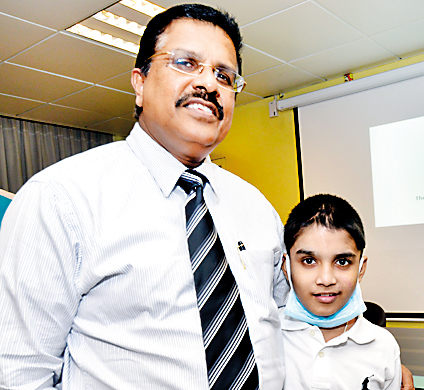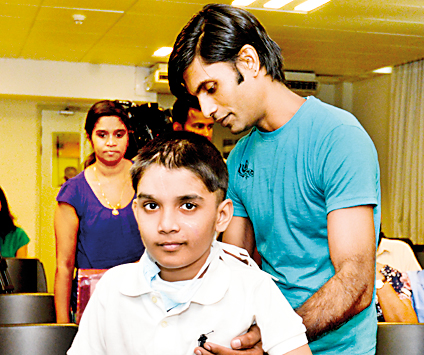Tuesday Dec 09, 2025
Tuesday Dec 09, 2025
Thursday, 16 June 2016 00:00 - - {{hitsCtrl.values.hits}}

Asiri Central Hospital Medical Director Dr. Harsha Baranage, Asiri Hospital Group CEO Dr. Manjula Karunaratne, Asiri Central Hospital Consultant Neurosurgeon Dr. Sunil Perera and Asiri Central Hospital Anesthetist Dr. Rohini Ranwala - Pix by Daminda Harsha Perera -Pix by Daminda Harsha Perera

Dr. Sunil Perera stands proudly with little Nethmina

Nethmina walks with the support of his father as he is still a little unsteady
By Fathima Riznaz Hafi
W.A.D.S.K. Nethmina, a bright 10-year-old boy from Embilipitiya, did his parents proud when he ranked ninth in position at the all-island Grade Five Scholarship Exam last year, boosting his hopes to be transferred to a school in Colombo and growing up to be a doctor. While his parents were rejoicing his accomplishment and making plans for his future that appeared bright and promising, it turned out that fate had other plans.
In October last year, on the very day that he received his certificate, he was headed back after the felicitation ceremony, when he met with a fatal motor accident that left him unconscious with a severe brain injury while his precious certificate was splattered with his blood.
He was first admitted to the National Hospital in Colombo and treated for a frontal fracture and foreign bodies with a CSF leak which was medically managed. He was discharged a week later but developed complications after that and was admitted to the Embilipitiya Hospital, from where he was transferred to the Neurological Unit at the Karapitiya Teaching Hospital, where he was diagnosed with meningitis and subdural empyema and underwent multiple operations. When discharged he was still not responding; his eyes were closed and he had no limb movements.
The parents of Nethmina’s classmates then told his father to take him to Asiri Central Hospital having heard about its Brain and Spine Centre and assured him that they would help with the finances. Following this assurance, the child was admitted to Asiri Central Hospital and attended to immediately under the guidance of Asiri Central Hospital Consultant Neurosurgeon Dr. Sunil Perera and his team, as he needed urgent surgery.
MRI scans that were performed at the Asiri Brain and Spine Centre revealed a large cyst in the right frontal region with severe hydrocephalous resulting from excess cerebrospinal fluid.
A frontal craniotomy, cyst decompression along with a programmable VP shunt insertion, was performed, thereby saving the patient who has shown vast improvement ever since.
“When we took him to the Embilipitiya Hospital, he was unconscious. From Embilipitiya we took him to Karapitiya Hospital. He was finding it difficult to breathe by the time we took him to Central Hospital. Parents of my child’s classmates got together and helped to take him there. They know that he’s a clever child and did well in his scholarship exam and wanted to help. That’s when the Central Hospital team took over and saved him. I am very grateful to them because they took good care of him and saved him when he was brought to them in a condition where he couldn’t breathe,” said Nethmina’s father at a press conference held recently at the Asiri Central Hospital.
Little Nethmina was also present at the conference and walked slowly holding on to his father for support as he was still a little unsteady. After looking around the room as the people watched him in amazement and pride, taking pictures of the lucky little boy, he sat with his mother and younger sister, while his father and the doctor who saved him talked about his remarkable journey. After a while he fell asleep at his seat and after the short nap, he woke up in time to pose for more pictures.
Identify at the right time
Asiri Central Hospital Consultant Neurosurgeon Dr. Sunil Perera noted, “The tragedy here is that after the accident when the child was discharged he was normal, walking and talking. Complications came up later when he developed a high fever and went unconscious again. The child should not have gone through all of this – it could have been avoided if the problem was identified and treated at the right time!”
“At the time of the accident there was a fracture in the brain that resulted in a leak of fluid; the infection got through because of the leakage. When there is water coming down obviously an infection goes in. This was not identified at the right time. Ideally what should have happened was they should have kept the child, treated the child and made sure there was no leak at all,” he added.
Explicating what had happened to the patient’s brain by the time he was brought to him and referring to MRI images of Nethmina’s brain he said that everybody has water (cerebral spinal fluid) inside the brain. It is produced inside and goes around the brain and comes out. The water serves to protect the brain from injury; it also delivers nutrients and removes waste. It is then reabsorbed into the blood. We are left with 150 ml which is about half a cup.
There is 150 ml of fluid inside the brain of a normal child. In this child the ventricles (water-containing cavity) have dilated and he has about 1 litre of fluid inside the brain. So there is a lot of fluid which is accumulating inside the brain. Obviously when you have accumulation of water that means there is pressure on the brain.
In addition to that there is a large cyst containing water. This is outside the ventricular system. So they had to go in, take out the water from that cyst and the cyst had to be communicated into the ventricular system. It then became one cavity. He added that there is always a connection.
Insertion of VP Shunt
The operation lasted six hours and involved a cyst penetration and insertion of a ventriculoperitoneal (VP) shunt. “We put a highly sophisticated ‘shunt’ – that’s a tube – into the hole and connected it into the abdomen through a sophisticated valve system. We used a ‘programmable shunt’, where we can actually change the shunt pressures from a remote control. This is one of the most sophisticated shunt systems in the world. If you put a shunt which cannot be controlled, you will not be able to control the amount of water which flows because the pressure might change as time goes on. It is a life-long shunt.
“The moment you take the fluid out, the brain expands because this is a growing brain. In a very old person if I do this, the brain will collapse. In this child it won’t happen – it expands,” he said.
Joint act of kindness
While expressing his appreciation of Dr. Perera’s work, Asiri Hospitals Group CEO Dr. Manjula Karunaratne added that the hospital’s state-of-the-art equipment supported his efforts. “We have bought some of the very latest brain surgery equipment. This is probably the best brain and spine centre in the country,” he said.
The Asiri Brain and Spine Centre is a world class facility with the best neurosurgeons, neurologists, specialist stroke physicians and interventional neuro-radiologists in its team and is the first in Sri Lanka to have all the facilities under one roof.
This is not the first time Dr. Perera has carried out surgery of this calibre but the distinctive nature of this case is that due to the high costs of the treatment an underprivileged child like Nethmina would not have had access to it. Nethmina’s surgery, hospital charges and additional costs would have come close to Rs. 2 million and would only have benefitted a wealthy patient. Children like Nethmina who come from poor families would never have been able to meet these costs and would therefore have given up hope of recovery.
Nethmina was fortunate to have been surrounded by so much love and kindness as is evident by the generosity of citizens who came forward to cover the costs of his treatment. Dr. Perera and Anaesthetist Dr. Rohini Ranwala’s services were provided completely free of charge and most of the hospital’s costs were also waived off.
The expertise of the team, state-of-the-art facilities of the hospital and generosity of the staff and citizens have all contributed to Nethmina’s recovery. This joint effort by a caring group of people is indeed a praiseworthy act.
Nethmina is now taking medication to prevent seizures. He is also undergoing physiotherapy and speech therapy. Dr. Perera is confident that considering the rate at which he is progressing, he will soon be able to return to school.
 Images of Nethmina’s brain show dark areas where a large quantity of cerebrospinal fluid has accumulated
Images of Nethmina’s brain show dark areas where a large quantity of cerebrospinal fluid has accumulated